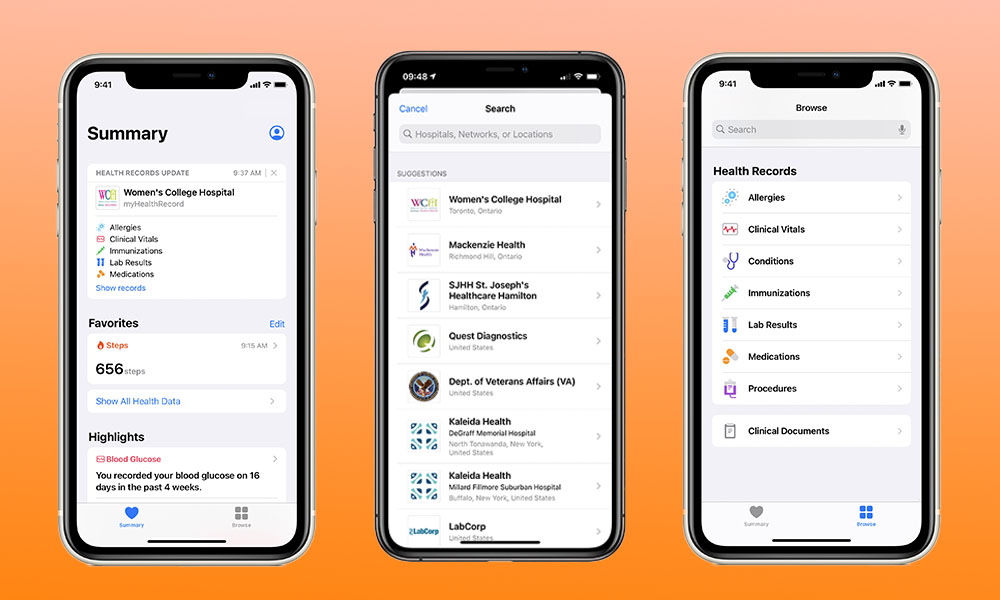Apple’s Health Records Feature Expands into Canada and the U.K.
 Credit: Jesse Hollington / Apple
Credit: Jesse Hollington / Apple
Toggle Dark Mode
Two years ago, Apple launched a new “Health Records” feature as part of its ever-widening push to revolutionize personal health care, promising to allow for much easier access to and sharing of private health records digitally, all while guaranteeing the utmost privacy and security of this sensitive data.
As with many of Apple’s new health initiatives, however, the rollout of Health Records was originally limited only to the U.S. In this case, it wasn’t so much a matter of awaiting the kind of regulatory approval required for features like the Apple Watch ECG, but more a question of guaranteeing compliance with the necessary privacy laws in different countries, and of course, getting actual health care providers on board.
What’s the Point?
The whole point of Health Records is to allow you to access and share your medical records with organizations such as hospitals, labs, and of course, your own doctor. The feature does you absolutely no good if those organizations aren’t willing to play nice with Apple’s Health Records frameworks.
Even in the U.S., the adoption of the Health Records feature was somewhat slow, really only gaining major traction last year after Apple announced a major partnership with the Veterans Health Administration — the largest single medical system in the U.S.
To be fair, the costs and complexities of accessing medical records aren’t nearly as bad as they once were; you no longer have to pay hundreds or even thousands of dollars to get physical copies as many health care providers offer patient portals where you can log on and see this data, however when you’re dealing with multiple hospitals, labs, and specialists, it can get complicated to navigate all of these different web sites, which of course all provide different user interfaces and separate logins and passwords.
The promise of Apple’s Health Records is to unify all of these disparate systems to make the whole process of accessing health records much more seamless and provide a single secure repository to store all of them. This means that patients can not only view their health records online directly from Apple’s Health app, but they can consolidate all of their records in one place, giving them quick access to everything from immunization records to lab results and surgery reports.
Once this information is in the user’s Health app on their iPhone, it can also be easily shared with any other health care professionals who may need to have access to it, so for example, you might be able to actually provide a lab report to your doctor before the doctor themselves even get a copy, especially if you’re dealing with specialists across different health care networks.
Beyond the U.S.
Now it looks like Apple is finally ready to begin expanding its Health Records feature outside of the U.S. It was announced today that users in Canada and the U.K. will now have access to the feature, with a handful of health care providers have come on board in those countries.
To be clear, the Health Records feature has been accessible outside of the U.S. for some time, but of course, going to that section of the Health app would present a list of U.S. healthcare providers, which was relatively useless for most non-U.S. users.
Now, however, Apple has announced the addition of Oxford University Hospitals and Milton Keynes University Hospital in the U.K. along with three Canadian healthcare providers: Women’s College Hospital in Toronto, St. Joseph’s Healthcare in Hamilton, Ontario, and Mackenzie Health in Richmond Hill, Ontario.
In its announcement, Apple also emphasizes that all health data remains encrypted at rest, protected by the user’s passcode and Touch ID or Face ID, and adds that it worked closely with several leading health information technology companies to enable the Fast Healthcare Interoperability Resources (FHIR) standard that’s required for the secure and private exchange of health records.
While it’s a pretty small list of providers in Canada and the U.K. right now, especially compared to the 500 institutions and 11,000 locations available to U.S. patients, Apple notes that it’s still working on extending this to more hospitals and healthcare organizations in those countries. As usual, it hasn’t announced any specific plans beyond saying that “more medical facilities” will be added “in the coming months.”






